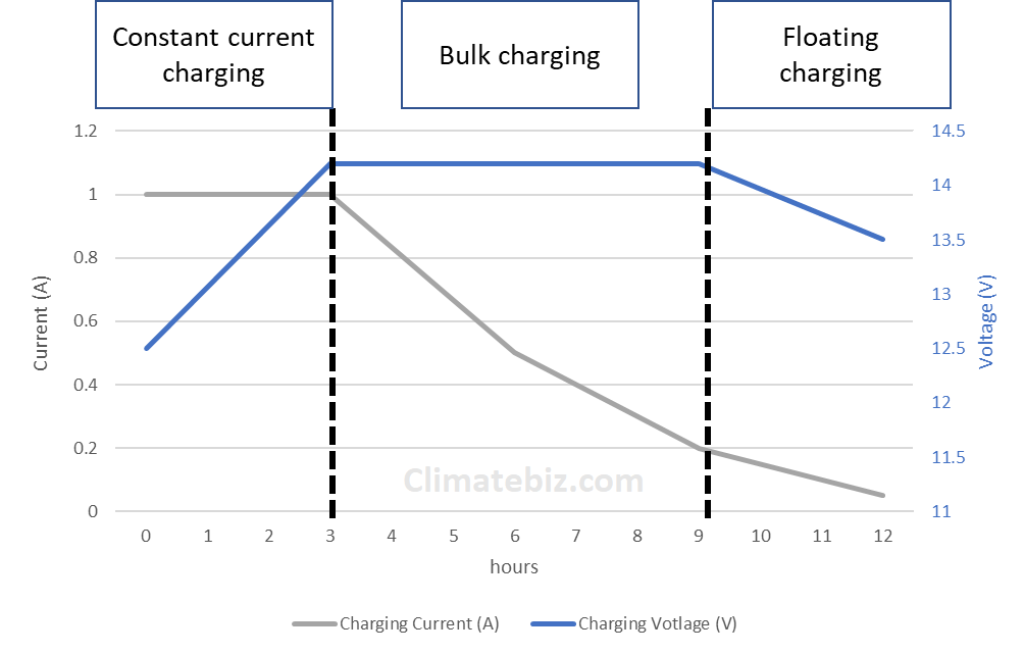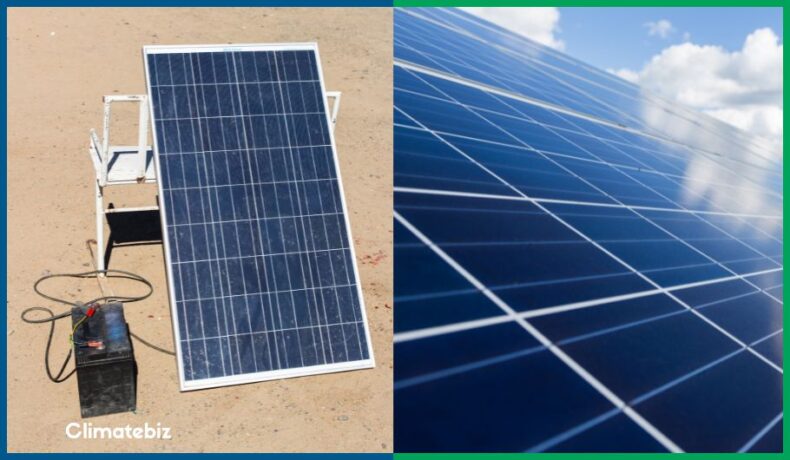PV panels and batteries both operate with direct current (DC). It’s, therefore, natural to assume that you can connect solar panels directly to a battery.
Sure, this may work for a low-power system (below 100W), but we’re about to show you that more suitable setups exist that utilize an additional component — a solar charge controller.
These devices charge your battery correctly and extend its lifetime.
Table of Contents
Can you connect solar panels directly to a battery?
Connecting your solar panels directly to a battery is possible but not advisable. In an emergency, this will only work for smaller systems (12V battery and solar panel below 100W).
If you have a 12V battery, you’ll have to ensure that the voltage of the solar panels (Vmp) doesn’t exceed 16V. Going above that limit will risk overvoltage and permanent damage to your battery.
Once the voltage is correct, connect the battery’s positive terminal with the solar panel’s positive output. Repeat the same process for the negative pole.
Remember that this is a temporary solution to charging your battery.
Tips
- Create an artificial shadow to lower your solar panel’s voltage to around 15V. This will reduce output current, but you won’t damage the battery.
- A battery management system (BMS) protects lithium batteries from overvoltage. It automatically disconnects the battery if the voltage reaches a certain threshold.
Note to our readers: Lead-acid batteries are more susceptible to damage than their lithium counterparts.
Why will a battery be damaged if it connects directly to a solar panel?
If your battery connects directly to a solar panel, it risks irreversible damage.
On the one hand, you have a solar panel that generates electricity, while on the other, you have a battery that uses solar energy to charge itself. Both electrical characteristics (voltage and current) must match for proper charging.
Solar panel electricity production
A solar panel is a variable generator whose power output depends on multiple factors, the most significant being solar irradiation. The stronger the sun, the higher the solar electricity production.
Electrical parameters, such as Vmp (voltage at maximum power) and Imp (current at maximum) characterize a solar module.
Multiplying Vmp by Imp gives you a solar panel’s maximum power output.
Vmp (V) x Imp (A) = Wp (W)
As shown in the figure below, the voltage (Vmp) mostly stays constant at all irradiation levels (shadow to full sun). In contrast, if solar power is low, the current drops by a factor of 4.

Example
Let’s use a 20W solar panel with the following characteristics: Vmp=17V, Imp=1.16A
Its output voltage will remain 12V-17V all day long, while its Imp will vary from 0.25A to 1.16A.
Battery charging
Your battery is an electrochemical device that stores and supplies direct current (DC) during charge and discharge.
The lead-acid battery (AGM & Gel) has been the leading technology on the market for decades but is now being challenged by the lithium battery.
The standard voltages for these two types of batteries are 12V, 24V, and 48V.
Both batteries must follow a proper charging profile to maintain performance and avoid damage.
Charging lead-acid, AGM, and GEL batteries
Below is the 3-stage charging profile of a lead acid battery.

- Stage 1: From 0% to 20% state of charge. Current is constant, and voltage increases to reach max. value.
- Stage 2: From 20% to 95% state of charge. Voltage is at maximum value, and current decreases until the battery is full.
- Stage 3: From 95% to 100% floating stage. Maintain the battery to its highest state of charge.
Charging lithium batteries
Lithium batteries are more flexible than their lead-acid counterparts and only follow the first two charging stages. Consequently, they can reach full charge in a couple of hours vs. 12 hours for a lead-acid battery.
It’s best practice to limit a lead-acid battery’s charging current to 0.3C. Lithium batteries, however, can charge up to 1C, although 0.5C is best.
Note to our readers: “C” represents a battery’s capacity.
For example, you can charge a 100Ah battery at 0.3C = 0.3 x 100= 30A. This is a constant charging current of 30 amps.
Solar panels directly connected to a battery
You’ve seen that:
- Batteries have to follow a specific charging profile.
- A solar panel’s current and voltage vary throughout the day.
You’re probably sensing the issue we’re facing here — the electrical characteristics of the battery and the solar panel (I and V) don’t match. This explains why a battery incurs damage if it connects directly to a solar panel.
Moreover, lead-acid batteries are at high risk of damage from overvoltage if a solar panel charges them directly.
Fortunately, lithium batteries have a built-in battery management system (BMS) that protects the battery pack from overcharging and overvoltage. Therefore, the risk of damaging a lithium battery is low.
Nevertheless, it’s still not advisable to directly connect a lithium battery to a solar panel.
What is the best way to connect solar panels to a battery?
The best way to connect solar panels to a battery is through a solar charge controller, also called a solar battery charger.

The solar charger has two functions:
- Optimize solar energy harvesting.
- Properly charge the battery.
Optimizing solar energy production
We’ve seen that solar panels are variable generators. The solar charge controller has a built-in algorithm that optimizes power generation from the solar panel at all times.
There are two types of solar chargers: MPPT and PWM.
We highly recommend MPPT (Multiple Power Point Tracking) solar chargers; they are up to 30% more efficient than the PWM (Pulse With Modification) technology.
Charging the battery
Lastly, the charge controller follows the proper charging profile of the battery. There won’t be any damage, and you will extend your battery life.
Ensure that your solar charger is set to the correct battery voltage (12V, 24V, and 48V) and that it accepts all types of battery technology.
Final thoughts
As a rule of thumb, you can connect your solar panels directly to a battery if the output voltage (Vmp) doesn’t exceed 35% of the rated battery voltage. That’s 16V max. for a 12V battery.
If the solar panel Vmp is too high (overvoltage), this will permanently damage your battery.
Finally, this configuration should only be for emergency charging. You’ll require a solar charge controller to charge the battery with a solar panel properly.
We recommend the MPPT technology, which offers efficiencies as high as 97% and a proper charging profile for the battery.
Don’t hesitate to get one for your system — starting at $10 on Amazon. This small investment will save you from buying a new battery.

